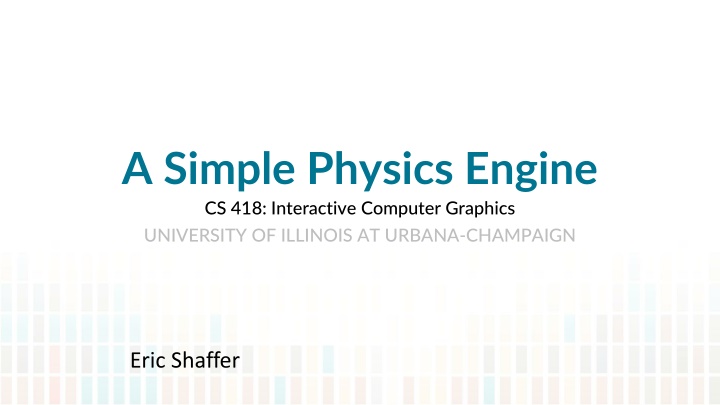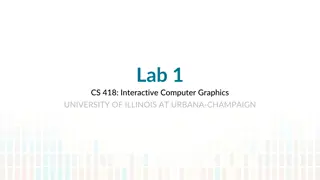
Simple Physics Engine for Interactive Computer Graphics
Learn how to create an interactive physics engine for computer graphics, covering topics such as Newtonian physics, forces, acceleration, gravity, and drag. Understand the fundamentals of integrating to compute position and velocity while animating particles in a simulated environment.
Download Presentation

Please find below an Image/Link to download the presentation.
The content on the website is provided AS IS for your information and personal use only. It may not be sold, licensed, or shared on other websites without obtaining consent from the author. If you encounter any issues during the download, it is possible that the publisher has removed the file from their server.
You are allowed to download the files provided on this website for personal or commercial use, subject to the condition that they are used lawfully. All files are the property of their respective owners.
The content on the website is provided AS IS for your information and personal use only. It may not be sold, licensed, or shared on other websites without obtaining consent from the author.
E N D
Presentation Transcript
A Simple Physics Engine CS 418: Interactive Computer Graphics UNIVERSITY OF ILLINOIS AT URBANA-CHAMPAIGN Eric Shaffer
Newtonian Physics We will animate particles (aka point masses) Position is changed by velocity Velocity is changed by acceleration Forces alter acceleration Our physics engine will integrate to compute Position Velocity We set the acceleration by applying forces
Force and Mass and Acceleration How do we update acceleration when force is applied? To find the acceleration due to a force we have So we need to know the inverse mass of the particle You can model infinite mass objects by setting this value to 0 For the MP, you can use a uniform mass of 1 Or make the masses different if you want
Force: Gravity Law of Universal Gravitation f =Gm1m2 r2 G is a universal constant mi is the mass of an object r is the distance between object centers if we care only about gravity of the Earth m1 and r are constants r is about 6400 km on Earth We simplify to f = mg g is about 10ms-2
Acceleration due to Gravity If we consider acceleration due to gravity we have So acceleration due to gravity is independent of mass
Acceleration due to Gravity In your MP the magnitude and direction of acceleration would be g= 0,-g,0 For gaming, 10ms-2 tends to look boring Shooters often use 15ms-2 Driving games often use 20ms-2 Some tune g object-by-object
Force: Drag Drag dampens velocity Caused by friction with the medium the object moves through Even neglecting drag, you need to dampen velocity Otherwise numerical errors likely drive it higher than it should be A velocity update with drag can be implemented as important to incorporate time so drag changes if the frame rate varies for the MP, have all objects have the same drag, calculate once per frame What range should d be in?
The Integrator The position update can found using Euler s Method: ????= ????+ ?? This is a pretty inaccurate approximation of analytical integration formula gets more inaccurate as acceleration gets larger why? In general we can characterize Euler method error as O(t) good enough for the MP The velocity update is computed using Euler integration as well
The Integrator You should ideally use actual time for t or some scaled version of it In JavaScript, Date.now() returns current time in ms so keep a previous time variable each frame find out how much time has elapsesd or you could use some uniform timestep you like
Collision Detection Surprisingly complex topic Even a high-quality engine like Unity has issues We will discuss how to simulate only two types of collision Sphere-Wall Sphere-Sphere We check for a collision when updating position If a collision occurs the velocity vector is altered Position is determined by the contact Position and velocity update are completed with new values over the remaining time
Dynamic Collision Detectin Dynamic collision tests an exhibit tunneling if only the final positions of the objects are tested (a) Or even if the paths of the objects are sampled (c) A sweep test assures detection .may not be computationally feasible.
Sphere-Plane Collision Why is it ? ? Can make it even simpler for the box walls in MP. How?
Velocity Direction after Collision What direction to use after a sphere collides with a plane? It s the same as calculating the direction of a reflected ray ??= ?? 2? ?? ? The diagram below is in 2D does anything change for 3D?
Speed After a Collision First, find closing (aka separating) velocity Component of velocity of two objects in direction from one to another Collisions that preserve momentum are perfectly elastic We will use vs_after = -cvs c is the coefficient of restitution a material property that you choose Why is it c?

